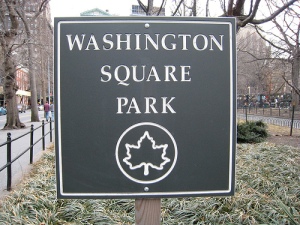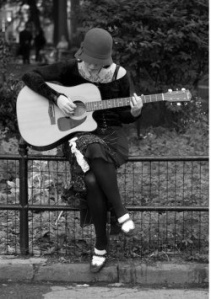An English Elm is the species of the tree which resides in the NorthWest Quadrant of Washington Square Park, the tree that is largely (and ironically, somewhat fondly) referred to as the “Hangman’s Elm.” Although there are no records of an actual hanging from the tree, at some point, it was given this name and it stuck. Perhaps because it looks so old, so majestic, and so strong, you can certainly imagine a hanging occurring from the tree in the 1800s, a century the tree lived through. In 1989, the Parks Department determined the age of the tree to be 310 years old, making it now 333. It is the oldest known living tree in Manhattan.
I contacted Bronx-based arborist Ralph Padilla to find out more about the English Elm in general, why healthy trees might get stressed, and if the Parks Department’s plan to trim branches of this tree ultimately made sense.
Padilla says that a healthy English Elm has wood so strong that “ordinarily you could hang a school bus from it,” the exception being when it is under stress or has “a defect or hole.”
Recently, Community Board 2 was alerted by the city’s Parks Department about concerns around the state of the tree and a plan to remove some of the majestic Elm’s branches. Community members were greatly concerned. The Parks Department provided this statement as far as their course of action and why:
Parks Department statement on the status of the Washington Square English Elm:
A ground based visual tree inspection and a subsequent aerial climbing inspection of the Washington Square Park English Elm found evidence of decay and strength loss. Approximately 20% of its crown will be removed in stages to reduce the mechanical stress experienced by its stems and branches and avoid the complete removal of the tree. The tree will also be treated against Dutch Elm Disease in the next few weeks.
When I read Padilla the statement the Parks Department gave in relation to the Hangman’s Elm, he said that it sounded “pretty reasonable.” He said if there is concern about “the vulnerability of the branch” which could break off, instead of removing the entire branch, “the strategy is to reduce weight … to prune away a bit. Now, it definitely won’t break.” Given the concerns, he said the way the city agency was proceeding sounded “very good.” As we spoke, he shed light on what might cause the stress the tree was under and that “decay and strength loss.”
Recent Criticism of City’s Parks Department over Maintenance of Trees
Recently, the Parks Department has been heavily criticized for its oversight of the health of the city’s trees resulting in deaths and injuries. On the one hand, great that they caught the problem with the Hangman’s Elm before something serious happened, but, on the other, is something else being ignored? That something is inadequate protection of our city trees during construction projects.
Padilla said, “Ordinarily with an overly mature tree, you never remove any green parts. There is barely enough food to power the entire system.” He said “the real plant food comes from the leaves which convert sunlight and energy into sugars. These sugars are the only real plant food.” (Fascinating!) He didn’t think, given the assessment, that there was much other option than the route they were taking. But I wonder why is the tree in this precarious state?
Protection around park trees during construction “a joke”
When I mentioned the park’s continuous construction and that the branches that were recently removed were at the top of the tree, he said, “When the branches at the top of a tree die off, the problem is in the root area; a disturbance of the root zone. The root zone of this tree would be far reaching – possibly half way across the park.“
He continued, “Construction and trees almost never work out because the protection is so half ass. I didn’t see the protection they took but the right protection for this tree would be a chain link fence 30 feet out from the trunk.”
When I explained that the protection consisted of four rickety wood slats right around the trunk of the tree, he said “that’s a joke.”
This is what the “protection” around all the park’s trees during construction has looked like over the last four years, including the Hangman’s Elm:

WSP Tree “Protection” Could Certainly be Improved (October 2009)
Basically what happens, according to Padilla: “When the roots get damaged, the tree will sacrifice the tippy top to direct energy into the root system in order to make repairs where the roots were damaged.” (Also fascinating!)
Padilla did say that treating the elm for Dutch Elm disease is smart since the insect that is the vector for Dutch Elm Disease is attracted to holes and the cutting of the branches could make the Elm susceptible.
Can we change the city’s practices and prompt appropriate care of our city’s trees?
So, we have to send some good energy to the Hangman’s Elm. Perhaps it can be a lesson. NYC needs to make necessary and major changes in the way our trees are being protected during construction.
The Bloomberg Administration has made much of its “Million Trees” Initiative while not providing funds for the necessary maintenance of these new trees as well as existing ones. It becomes difficult not to believe it’s all a p.r. ploy. Now, we have the situation before us with the 333 year old “Hangman’s Elm” and its decline and it’s impossible not to point to the construction and the fact that necessary precautions have not been taken.
Will the Bloomberg’s Administration’s dramatic redesign of Washington Square Park be the cause of the demise of the oldest known living tree in Manhattan?
******************************************************************************
Very cool Time Lapse video from 7:19 p.m. to 9:35 p.m. of the Hangman’s Elm one day in April 2012 from Kristin Jones and Andrew Ginzel:
* Wikipedia Hangman’s Elm
* How to Prevent Additional Trees at Washington Square Park from Dying – Questions Abound WSP Blog, August 23, 2011
* Training to spot Tree Decay is Urged for Parks Workers New York Times, May 31, 2012
* Kristin Jones’ “Behold,” Slated for Arbor Day 2013, Has Eye on Hangmen’s Elm at Washington Square WSP Blog, December 19, 2011
























